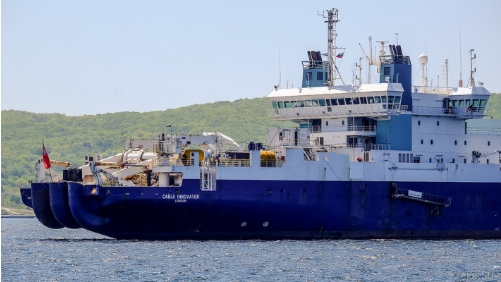

Dan huwa assi ġdid ta' Prysmian li se jżid mas-saħħa tal-flotta eżistenti tat-tqegħid tal-bastiment tal-kejbil taħt il-baħar Prysmian., li jippermettilha taħdem b'mod aktar effiċjenti fi proġetti ta' żvilupp ta' sistema ta' enerġija ekoloġika madwar id-dinja.


Dan huwa assi ġdid ta' Prysmian li se jżid mas-saħħa tal-flotta eżistenti tat-tqegħid tal-bastiment tal-kejbil taħt il-baħar Prysmian., li jippermettilha taħdem b'mod aktar effiċjenti fi proġetti ta' żvilupp ta' sistema ta' enerġija ekoloġika madwar id-dinja.
L-ewwel kompitu tal-bastiment il-ġdid huwa li tpoġġi l-kejbil sottomarini tal-Viking Link bejn ir-Renju Unit u d-Danimarka, l-itwal tad-dinja Konnessjoni tal-qawwa tad-Dirett ta 'Vultaġġ Għoli ta' Vultaġġ Għoli.
Aktar tard din is-sena, Il-bastiment se jintuża fi proġetti bħall-konnessjoni taħt l-ilma bejn il-gżejjer Spanjoli ta 'Lanzarote u Fuerteventura u l-farm tar-riħ offshore Franċiż f'Saint-Nazaire.
Il-bastiment tal-kejbil sottomarini huwa twil madwar 170m u 34 m wiesa 'u kapaċi joperaw ilma fond f'fond ta' fuq 3000 m.
Huwa ddisinjat apposta biex juża biss żejt tad-diżil tal-baħar b'kontenut ta 'kubrit hawn taħt 0.1%, jikkonforma mal-aħħar rekwiżiti tal-IMO 2020 (Kontenut tal-Kubrit <0.5%) u ECA (Kontenut tal-Kubrit <0.1%), u jista 'jbaħħar mingħajr restrizzjonijiet ġeografiċi.
Barra minn hekk, il-bastiment huwa mgħammar 80% Dawl aktar qawwi u konsum baxx LED dwal, Allura tnaqqas l-emissjonijiet tal-ġeneratur.
Grazzi għall-ġenerazzjoni li jmiss Teknoloġija tal-kejbil, Il-bastiment huwa armat b'materjali eħfef.
Il-veloċità massima għadha kemm intemmet 16 għoqod; b'7,000 tunnellata u 10,000 tunnellata turntables, L-iżgurar tal-ogħla kapaċità tat-turntable fis-suq, Tnaqqis tal-ivvjaġġar minn fabbrika għal sit.
Iż-żieda ġenerali fl-effiċjenza tal-proġett b'żewġ linji ta 'tqegħid indipendenti għal flessibilità operazzjonali akbar.
U ġibda ta 'bollard 180 tunnellati bil-kapaċità li jwettqu operazzjonijiet ta 'installazzjoni kumplessi u jappoġġjaw varjetà ta' għodda ta 'tqegħid.
Fl-istess waqt, Il-vapur huwa mgħammar b'sistema ta 'pożizzjonament DP3 ta' l-arti u tal-baħar ta 'l-istat.
It-tagħmir kollu tal-immaniġġjar u tal-installazzjoni tal-kejbils huma ddisinjati minn Prysmian.
It-tnaqqis fil-ħin ta 'transitu meħtieġ jirriżulta fi tnaqqis ġenerali fl-emissjonijiet tas-CO2 u l-konsum tal-fjuwil ta' madwar 40% Meta mqabbel ma 'bastimenti konvenzjonali li jbidu l-kejbil.
When choosing the right rubber cable for an electrical engineering project, it is critical to…
Għeżież Imsieħba u Klijenti: 29 ta 'Jannar, 2025 Is-Sena l-Ġdida Lunar Ċiniża hija – Spring…
Ir-ram wajer huwa komponent fundamentali fid-dinja tal-inġinerija elettrika u l-elettronika, valued…
Tħabbira lill-klijenti u l-imsieħba kollha, Riċentement, there has been sufficient evidence that other…
Fl-okkażjoni tas-Sena l-Ġdida 2025, ZMS Cable wishes every customer and partner a…
L-industrija medika Ewropea rat avvanzi sinifikanti f'dawn l-aħħar snin, driven by the integration…